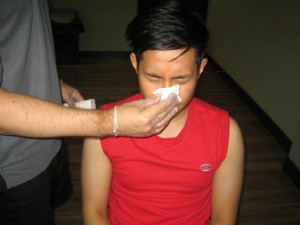Nosebleeds can happen due to the irritation of the nasal membranes, trauma such as getting into a fight or a direct hit by a ball. Nose bleeding is not a dangerous condition but can also be a sign of a more serious condition if the bleeding happens frequently. Children ages 2 to 10 years are more susceptible to nosebleeds but this can also happen to anyone. The severity of the bleeding will depend on some factors such as the location where the bleeding started. Bleeding that starts from the front of the nose, it is called anterior nosebleed. If bleeding is at the back of the nose, it is called posterior nosebleed.
Elderly people are more susceptible to posterior nosebleeds, where the nosebleed starts from the artery that is located at the back of the nose. Such cases are considered complicated and requires medical help.
Nosebleed symptoms
- The need to swallow frequently caused by a blocked feeling in the nasal passages.
- The presence of blood from either one or both the nostrils
- The presence of a reddish-brown powdery substance found in the tissue after wiping the nose.
- The feeling of a fluid at the back of the nose and throat.
- Difficulty in breathing and a sensation of choking
- If the symptoms of nosebleed last for more 30 minutes, seek medical help immediately.

Causes of nosebleeds
- Foreign object that is stuck inside the nasal passages
- Nasal and sinus infections
- Allergic rhinitis
- Perforation or deviation of the nasal septum
- Sneezing excessively and blowing the nose vigorously
- Too much exposure to dry and warm air for long periods of time
- Vascular formations in the nose
- Using of illegal drugs such as cocaine
- Clotting disorder that runs in the family
- Exposure to chemicals such as ammonia
- High blood pressure
- Common colds and excessive use of nasal sprays
Treatment and home remedies of nosebleeds
- Press the thumb against a bleeding nostril. If the right nostril is bleeding, use the right thumb. If the left nostril is bleeding, use the left thumb and press it firmly until it is closed.
- Place an ice pack over the bridge of the nose. The ice will constrict the blood vessels which stops the bleeding. Keep the ice on the nostril at least for five minutes and apply a steady pressure to stop the bleeding.
- Avoid blowing the nose for 20 minutes when the bleeding stops in order to prevent the clots from being dislodged and start bleeding again.
- Apply a cold compress in order to help slow down the flow of blood, make it clot faster which will stop bleeding within a few minutes. Apply compress directly on the nose for at least 5 minutes. In case an ice pack is not available, ice cubes can be placed in a plastic bag or a towel, another is a bag of frozen vegetable also helps with the condition.
